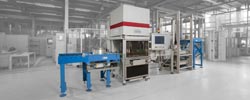Quality control in the manufacturing cycle

The “Wheelinspector” makes non-contact measurement of light-alloy wheels directly in the production process possible for the first time. © Fraunhofer IFF<br>
Up to eighty geometric features, such as radial and axial runout, width and diameter, relevant to vehicles wheels’ function are inspected before they are launched on the market.
These have usually been inspected randomly with tactile measurement and under laboratory conditions away from the production line – for instance, in a room adjacent to the production floor. The procedure takes up to approximately forty-five to sixty minutes per wheel, thus making it impossible to inspect 100 percent of the wheels produced. Defects and their causes are detected and rectified only with some delay.
Together with its industry partner Ascona GmbH, a specialist for optical profile measurement systems headquartered in Meckenbeuren in the Lake Constance district, Fraunhofer experts developed the “Wheelinspector”. “The system makes fully optical, non-contact measurement of light-alloy wheels directly in the production process possible for the first time,” explains Ralf Warnemünde, Deputy Manager of the Measurement and Testing Technology Business Unit at the Fraunhofer IFF. “Immediately after they have been machined, that is, turned, milled and drilled, the new 3D laser technology compares real finished products with their digital model. It scans a multitude of geometric parameters and, with a cycle time of twenty seconds to inspect one wheel, can be integrated fully in the production flow.” The measurement system does more than just assure quality: A manufacturing unit can respond to deviations from process parameters without delay and thus organize production processes far more cost effectively.
The basis of the system is the OptoInspect 3D technology developed at the Fraunhofer IFF, which operates with triangulation that measures points and lines. The system uses a laser light projection. A camera registers the light of the projection reflected diffusely by the part. On the basis of the perspective, the laser projection in the camera image changes according to the wheel’s shape.
The “Wheelinspector” measurement system consists of four sensors and a complex system of axes for moving and positioning the sensors during measurement. This guarantees high flexibility; the system can inspect a wide variety of products in the same machine – even when regularly switching between different types of wheels.
Inspection proceeds thusly: Wheels are rolled into the measuring unit on a conveyer, are centered and locked in place mechanically. An image-based identification system upstream recognizes the particular type of wheel and transmits specific features, such as diameter, width or offset, to the measuring unit. These coordinates are used to align each of the positioning axes of the sensors to their correct position. The sensor cluster revolves around the wheel 360 degrees and scans the measured values. The entire scanning cycle for one wheel is completed after approximately twenty seconds.
The system compares the results of 3D measurements with the tolerances from the 3D CAD model of the vehicle wheel. Deviations of parts resulting from tool wear or breakage are reported to the machines immediately. This prevents serial defects and resulting costs.
The “Wheelinspector” is already being used successfully in the automotive supplier industry. Attendees of Control 2013 will be able to see how the technology works live: The Fraunhofer Vision Alliance will be presenting a wheel inspection system together with the “Wheelinspector” at the trade fair in Stuttgart.
United under the theme “3D Image Processing for Industrial Quality Assurance”, the sixteen institutes involved will be displaying other highlights such as visualization software for 3D terahertz data, which makes the invisible visible.
Media Contact
All latest news from the category: Trade Fair News
Newest articles

Recovering phosphorus from sewage sludge ash
Chemical and heat treatment of sewage sludge can recover phosphorus in a process that could help address the problem of diminishing supplies of phosphorus ores. Valuable supplies of phosphorus could…

Efficient, sustainable and cost-effective hybrid energy storage system for modern power grids
EU project HyFlow: Over three years of research, the consortium of the EU project HyFlow has successfully developed a highly efficient, sustainable, and cost-effective hybrid energy storage system (HESS) that…

After 25 years, researchers uncover genetic cause of rare neurological disease
Some families call it a trial of faith. Others just call it a curse. The progressive neurological disease known as spinocerebellar ataxia 4 (SCA4) is a rare condition, but its…





















